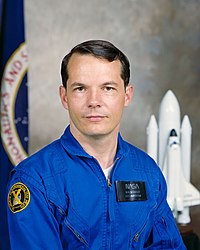Robert L. Stewart
| Robert Stewart | |
|---|---|

|
|
| Country: | United States |
| Organization: | NASA |
| selected on | January 16, 1978 ( 8th NASA Group ) |
| Calls: | 2 space flights |
| Start of the first space flight: |
3rd February 1984 |
| Landing of the last space flight: |
October 7, 1985 |
| Time in space: | 12d 0h 49min |
| EVA inserts: | 2 |
| EVA total duration: | 12h 12min |
| retired on | January 1986 |
| Space flights | |
Robert Lee Stewart (born August 13, 1942 in Washington, DC , USA ) is a retired American astronaut . Stewart received a bachelor's degree in mathematics from the University of Southern Mississippi in 1964 and a master's degree in aerospace engineering from the University of Texas at Arlington in 1972 .
In May 1964, Stewart joined the United States Army . After training as an army pilot, he flew numerous helicopter combat missions in Vietnam from August 1966 to 1967. He then worked as a pilot instructor for helicopters. From 1972 to 1973 he was stationed in South Korea and completed his training as a test pilot in 1974. At Edwards Air Force Base , he tested both airplanes and helicopters.
Astronaut activity
In January 1978, Stewart was selected as an astronaut candidate by NASA. His tasks in the astronauts office included testing the re-entry flight control system for the first space shuttle mission STS-1 , as well as developing aborted take-off procedures and coordinating the payload. He was on the support team for the STS-4 mission and liaison officer ( CAPCOM ) for the STS-5 mission .
STS-41-B
Stewart took off on February 3, 1984 with the space shuttle Challenger for its first flight into space . Together with Bruce McCandless he tested the Manned Maneuvering Unit (MMU), with McCandless undertaking the first test flight on February 7th. This made Stewart the second person to float completely free in space. The shuttle had the two satellites WESTAR-VI and PALAPA-B2 on board as cargo. However, due to a failure of the Payload Assist Module-D (PAM-D), they entered an orbit that was too low. The space shuttle landed for the first time in the Kennedy Space Center in Florida.
STS-51-J
Next, on October 3, 1985, Stewart was Mission Specialist on the maiden flight of the space shuttle Atlantis . The mission was to deploy two military DSCS III communications satellites. These were brought into geostationary orbit using an IUS rocket stage .
STS-61-K
STS-61-K was a Columbia mission that was canceled because of the Challenger disaster . The EOM-1 shuttle mission was scheduled for October 1986. In addition to Stewart, the crew included Vance Brand , David Griggs , Owen Garriott , Claude Nicollier and the three payload specialists Byron Lichtenberg , Michael Lampton and Robert Stevenson .
According to NASA
During his training for the STS-61-K mission , Stewart was promoted from the Army to Brigadier General. Stewart accepted the promotion and moved to the US Army Strategic Defense Command in Huntsville , Alabama as deputy commanding general . In 1989 he was transferred as planning director to the US Space Command in Colorado Springs . In 1992, Stewart retired from the Army and became a director at Nichols Research Corporation in Colorado Springs.
Private
Robert Stewart is married with two children.
See also
Web links
- Short biography of Robert L. Stewart at spacefacts.de
- NASA biography of Robert L. Stewart (English; PDF)
- Biography of Robert L. Stewart in the Encyclopedia Astronautica (English)
| personal data | |
|---|---|
| SURNAME | Stewart, Robert L. |
| ALTERNATIVE NAMES | Stewart, Robert Lee |
| BRIEF DESCRIPTION | American astronaut |
| DATE OF BIRTH | August 13, 1942 |
| PLACE OF BIRTH | Washington, DC , USA |